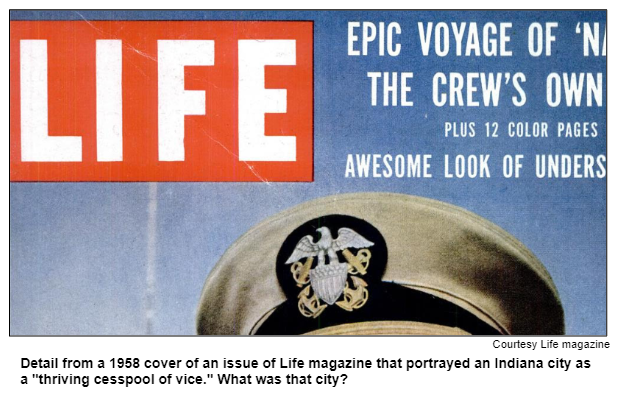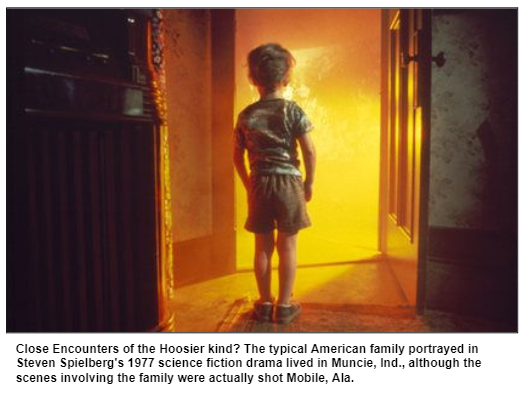
Saturdays, noon to 1 p.m. ET on WICR 88.7 FM.
Or listen live from anywhere on WICR Online!
Our call-in number during the show: (317) 788-3314
January 5, 2019
Avriel Shull, trail-blazing home builder and designer
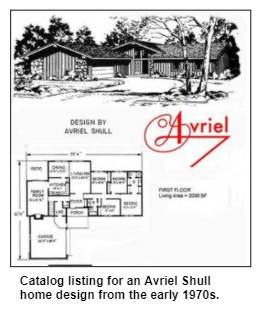
Beginning in the 1950s, when women home builders were a rarity, Avriel Shull designed and built mid-century modern homes in Carmel, Indianapolis and other cities. National periodicals eventually distributed the house plans of "Avriel" (she often was referred to by her first name only), with orders for her home patterns continuing long after she died in her mid-40s in 1976.
"Years before branding became an essential component of business success, Avriel was both a well-known company brand and a synonym for modern design," according to our guest, historian, researcher and preservationist Connie Zeigler, owner of C. Resources. Connie prepared the nomination for the National Register of Historic Places of the Thornhurst subdivision in Carmel, where Avriel designed 21 mid-century modern homes.
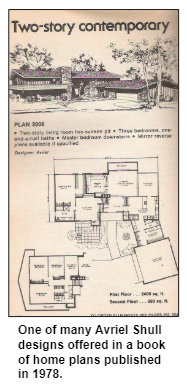
In 1951, Life magazine devoted a multi-page photo spread to her splashy wedding, during which Avriel entered amid a release of white birds; at 2 a.m., she lifted her white gown to perform the can-can.
Her husband was one of Indiana's best-known journalists of the era. An irreverent TV columnist for the Indianapolis News (and, before that, for the Indianapolis Times), R.K. Shull also answered reader questions in "Shull's Mailbag," which appeared in 260 newspapers across the country.
None of that overshadowed his wife, who, as Connie has written, "lived life at breakneck speed."
According to Connie, Avriel "often laid the stone herself on the houses she designed." As for an enduring architectural legacy, Connie notes that "At least 50, and probably more, of her houses are still standing in the Indianapolis area."

In all of her Thornhurst subdivision houses - which were the focus of a 2017 home tour organized by the Carmel Clay Historical Society - Avriel featured modern fireplaces, some of which she built herself.
In a cover story about Avriel for a 2012 issue of Traces magazine published by the Indiana Historical Society, Connie notes that many of the fireplaces "had two-sided hearths opening into two different rooms."
Connie writes that for home interiors, Avriel chose vinyl-topped stools, tripod-legged lamps and sofas with hairpin legs, "unlike the ruffled sofas and overstuffed chairs of earlier eras." In many of the bathrooms, she painted murals - and added an elaborate "Avriel" as a signature to her work.
By the mid-1960s, Avriel landed contracts to design homes in upscale neighborhoods on the northside of Indianapolis including Avalon Hills, Crow's Nest, Meridian Hills and Sunset Lane. In the final years before her death shortly before her 45th birthday, Avriel was building houses in Brownsburg, Kokomo, Westfield and Evansville.

History Mystery
The multi-page photo essay about the wedding of home builder Avriel Shull in Life was one of many times during the 1950s that the magazine - which then was published weekly as one of the country's most widely read periodicals - focused on a topic related to Indiana.
In 1958, a six-page essay in Life described an Indiana city as "a thriving cesspool of vice." The illustrated article included descriptions of illegal gambling and prostitution in the Hoosier city.
For several years after the article's publication in 1958, it remained a topic of discussion in households across the state. Outraged and distraught, civic leaders in the Indiana city were quoted as worrying that it might cause "irreparable damage." Reacting to the Life article, a local newspaper published a front-page editorial with the headline: "A Low Blow If There Ever Was One."
Question: What Indiana city was the focus of the controversial article in Life magazine in 1958?
Please do not call in to the show until you hear Nelson pose the question on the air, and please do not try to win if you have won any other prize on WICR during the last two months. You must be willing to give your first name to our engineer, you must answer the question correctly on the air and you must be willing to give your mailing address to our engineer so we can mail the prize pack to you. The prizes this week are four admissions to the Indiana History Center, courtesy of the Indiana Historical Society, and a gift certificate to Story Inn in Brown County, courtesy of Story Inn.
Ringing in the New year with Hoosier History Live!
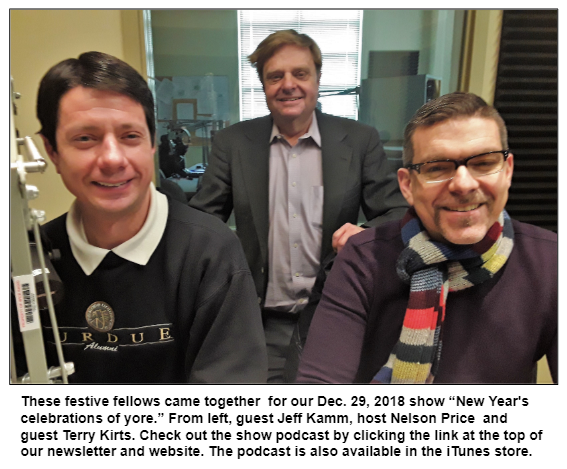
Hoosier History Live podcasts are now available at the Apple iTunes store!

Those who like to subscribe to podcasts can now find us in the Apple iTunes store as well - just open your iTunes app and search on Hoosier History Live. We're working to get listed on all the major podcast providers as well; send us an email if your favorite one doesn't carry us, and we'll make sure it gets posted there. We'll keep posting podcast links on our newsletter and website as before. And if you're looking for a podcast from a 2017 or 2018 show, just go to the Archive page on our website and you'll see the podcast link posted right below the show's title.
Thanks to associate producer Mick Armbruster for heading up our online distribution project. Our growing availability as a podcast and on iTunes is great news for our sponsors as well. More media reach!
New to podcasts? All you need is a computer or smartphone, and you can listen to radio shows (and more!) wherever and whenever you want. Confused by the new-fangled technology? Check out this guide to podcasts, provided by Wired Magazine.
Coming Soon: Our 11th anniversary party

Mark your calendars for our annual bash, hosted by our friends at Indiana Landmarks! The party will be held Thursday, February 28 from 5:00 to 7:30 pm at Indiana Landmarks Center, 1201 N. Central Avenue, Indianapolis, IN 46202. Come as you are, or (better yet!) dress in historic garb as your favorite character from the past.
More details to come!
Nelson Price, host and historian
Molly Head, producer/project manager, (317) 927-9101
Michael Armbruster, associate producer
Cheryl Lamb, administrative manager
Richard Sullivan, senior tech consultant
Pam Fraizer, graphic designer
Garry Chilluffo, special events consultant
Please tell our sponsors that you appreciate their support!

 Acknowledgments to Monomedia, Visit Indy, WICR-FM, Fraizer Designs, Heritage Photo & Research Services, Henri Pensis, Aaron Duvall, and many other individuals and organizations. We are an independently produced program and are self-supporting through organizational sponsorship, and by individual contribution at the yellow button on our newsletter or website. For organizational sponsorship, which includes logos, links, and credits in the show, contact Molly Head at (317) 927-9101 or email her at molly@hoosierhistorylive.org. And any of our podcasts can be sponsored for a nominal fee.
Acknowledgments to Monomedia, Visit Indy, WICR-FM, Fraizer Designs, Heritage Photo & Research Services, Henri Pensis, Aaron Duvall, and many other individuals and organizations. We are an independently produced program and are self-supporting through organizational sponsorship, and by individual contribution at the yellow button on our newsletter or website. For organizational sponsorship, which includes logos, links, and credits in the show, contact Molly Head at (317) 927-9101 or email her at molly@hoosierhistorylive.org. And any of our podcasts can be sponsored for a nominal fee.
Thank you!
We'd like to thank the following recent, new and renewal contributors whose donations help make this show possible!
- Bill McNiece
- Tom Spalding
- Joseph Leak
- Melissa Martin
- Diane Dallis
- Yetta Wolen
January 12, 2019 - coming up
Movies with obscure Indiana connections
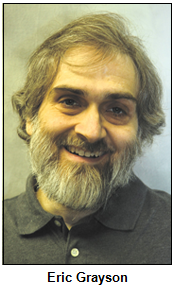 Even though Close Encounters of the Third Kind was considered a blockbuster after its release in 1977, many Hoosiers may have forgotten its connection to Indiana. No scenes were filmed in the state, but the central characters were described as residents of Muncie.
Even though Close Encounters of the Third Kind was considered a blockbuster after its release in 1977, many Hoosiers may have forgotten its connection to Indiana. No scenes were filmed in the state, but the central characters were described as residents of Muncie.
In a scene played for laughs in Brother from Another Planet (1984), the protagonist, an alien who doesn't speak, encounters wide-eyed tourists from Indiana on a subway in New York City.
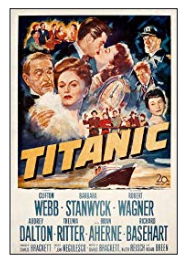
In the 1953 version of the film Titanic, a fictional passenger on the doomed ocean liner is a student at Purdue University. Played by Robert Wagner, the character is described as a college tennis star.
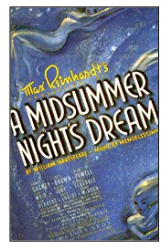
In addition to talking about movies with obscure links to Indiana, during our show Eric will share insights about actors and directors with Hoosier connections who - unlike the more famous James Dean, Steve McQueen, Carole Lombard and other stars - are seldom discussed today.

They include Otis Harlan (1865-1940), a comedian and character actor from Martinsville. According to Eric, Harlan was featured in hundreds of silent movies and early talkies, including a film version of A Midsummer Night's Dream (1935). Harlan also provided the voice of the dwarf Happy in Disney's animated Snow White and the Seven Dwarfs (1937).
Richmond native Norman Foster (1903-1976), an actor who enjoyed greater success when he became a director, also was involved in Disney projects. Foster was associated with Orson Welles for many decades, serving as the director of the spy thriller Journey into Fear (1943) starring Welles, as well as several Charlie Chan mysteries. As an actor, Foster had a major role in Welles' final movie, The Other Side of the Wind, which began filming in 1970; it was uncompleted when Welles died in 1985 and finally was released in 2018 after being reconstructed by other filmmakers.
Both Foster and Harlan were in the cast of The Hoosier Schoolmaster (1935), a movie based on a 19th-century novel by Indiana author Edward Eggleston. The setting is southern Indiana after the Civil War.
© 2019 Hoosier History Live. All rights reserved.
|

